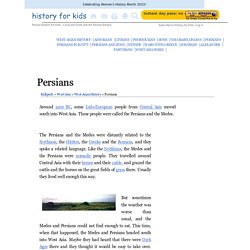

Ancient dam, Persia. Map of the extent of Persia in 490 B.C. Ancient Persia - HowStuffWorks. Persia, the name by which Iran was known until 1935.

This article deals with the people, culture, and history of Persia up to that time. For geography, agriculture, industry and commerce, government, and recent history, Persia is one of the oldest countries in the world. Where other historic nations built great empires and enjoyed a single period of grandeur before their decline, Persia rose to imperial conquest and greatness again and again. Its first empire was established in the 6th century B.C.; its last, in the 16th century A.D.
The ancient Persians, an artistic people, borrowed architectural forms and art motifs from Assyria. Ancient Persia: Kings. Persia: Ancient Soul of Iran. What's so striking about the ruins of Persepolis in southern Iran, an ancient capital of the Persian Empire that was burned down after being conquered by Alexander the Great, is the absence of violent imagery on what's left of its stone walls.

Among the carvings there are soldiers, but they're not fighting; there are weapons, but they're not drawn. Mainly you see emblems suggesting that something humane went on here instead—people of different nations gathering peacefully, bearing gifts, draping their hands amiably on one another's shoulders. In an era noted for its barbarity, Persepolis, it seems, was a relatively cosmopolitan place—and for many Iranians today its ruins are a breathtaking reminder of who their Persian ancestors were and what they did. Women's Lives in Ancient Persia. By: Massoume PriceCulture of Iran Any analysis of women’s lives and status in ancient times is a very complicated task and needs time and space.

This very brief article intends to provide much needed basic information based on archaeological evidence and will primarily deal with women in Achaemenid times. The material is based on Fortification and Treasury texts discovered at Persepolis (509-438 BC) and documents recovered at Susa Babylonia and other major Mesopotamian cities of the period.
These texts provide us with a unique insight into the social and economic situation of both the royal and non-royal women at the time. In the texts individual women are identified, payments of rations and wages for male and female workers are documented and sealed orders by the royal women themselves or their agents gives us valuable information on how these powerful women managed their wealth. Persian Empire Longevity (How It Lasted So Long) Maximinus, a member of the Ancient / Classical History forum, asked how the Persian Empire (modern Iran) managed to survive for as long as it did.
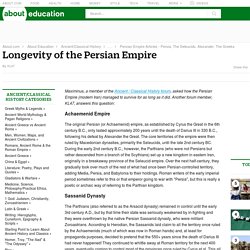
Another forum member, KL47, answers this question: Achaemenid Empire The original Persian (or Achaemenid) empire, as established by Cyrus the Great in the 6th century B.C., only lasted approximately 200 years until the death of Darius III in 330 B.C., following his defeat by Alexander the Great. Persian Empire. Persian Empire - Timeline and Definition. Battle of Salamis During the Persian Wars. Greco-Persian Wars. Alternate title: Persian Wars Greco-Persian Wars, also called Persian Wars, (492–449 bc), a series of wars fought by Greek states and Persia over a period of almost half a century.
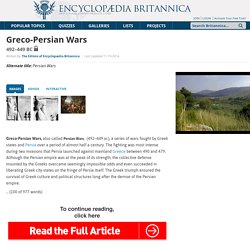
The fighting was most intense during two invasions that Persia launched against mainland Greece between 490 and 479. Although the Persian empire was at the peak of its strength, the collective defense mounted by the Greeks overcame seemingly impossible odds and even succeeded in liberating Greek city-states on the fringe of Persia itself. The Greek triumph ensured the survival of Greek culture and political structures long after the demise of the Persian empire. ... (100 of 977 words) <ul><li><a href="/EBchecked/media/107567/Darius-I-seated-before-two-incense-burners-detail-of-a?
Alexander Defeats The Persians, 331 BC. Alexander Defeats The Persians, 331 BC Alexander began his war against the Persians in 334 BC.
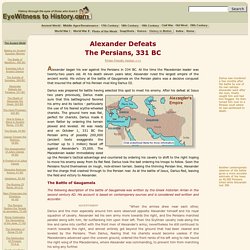
At the time the Macedonian leader was twenty-two years old. At his death eleven years later, Alexander ruled the largest empire of the ancient world. His victory at the battle of Gaugamela on the Persian plains was a decisive conquest that insured the defeat of his Persian rival King Darius III. Darius was prepared for battle having selected this spot to meet his enemy.
After his defeat at Issus two years previously, Darius made sure that this battleground favored his army and its tactics - particularly the use of his feared scythe-wheeled chariots. The Achaemenid Persian Empire (550–330 B.C.) The Achaemenid Persian empire was the largest that the ancient world had seen, extending from Anatolia and Egypt across western Asia to northern India and Central Asia.
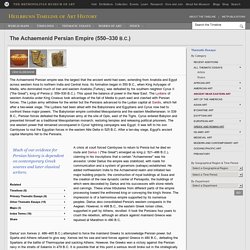
Its formation began in 550 B.C., when King Astyages of Media, who dominated much of Iran and eastern Anatolia (Turkey), was defeated by his southern neighbor Cyrus II ("the Great"), king of Persia (r. 559–530 B.C.). Battle of Marathon: Greeks Versus the Persians. On the morning of September 17, 490 bc, some 10,000 Greeks stood assembled on the plain of Marathon, preparing to fight to the last man.
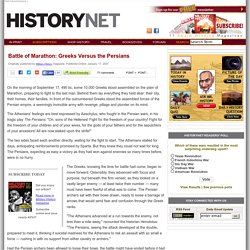
Behind them lay everything they held dear: their city, their homes, their families. Greco-Persian Wars: Battle of Thermopylae. In the 5th century bc, the Persian empire fought the city-states of Greece in one of the most profoundly symbolic struggles in history.
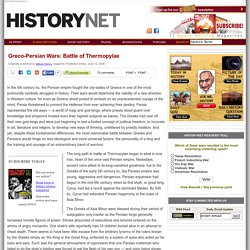
Their wars would determine the viability of a new direction in Western culture, for even as Greece stood poised to embark on an unprecedented voyage of the mind, Persia threatened to prevent the Hellenes from ever achieving their destiny. Persia represented the old ways — a world of magi and god-kings, where priests stood guard over knowledge and emperors treated even their highest subjects as slaves. The Greeks had cast off their own god-kings and were just beginning to test a limited concept of political freedom, to innovate in art, literature and religion, to develop new ways of thinking, unfettered by priestly tradition. The long path to battle at Thermopylae began in what is now Iran, heart of the once vast Persian empire. Darius' son Xerxes does not seem to have been especially driven to complete his late father's unfinished business.
Persian Battle of Thermopylae Summary (300 Movie) Persian Empire for Kids! Around 1200 BC, some Indo-European people from Central Asia moved south into West Asia.
